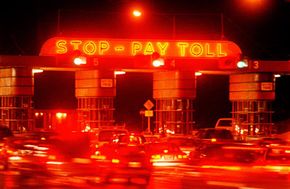Types of Municipal Bonds
The two most common types of municipal bonds are general obligation and revenue bonds. Both are exempt from federal, state and local taxes -- as long as you live in the issuing municipality. What's more, they're longer-term bonds, which take anywhere from one to 38 years to mature.
Advertisement
General obligation bonds are bonds that are backed by the taxing power of the issuing municipality [source: Securities Industry and Financial Markets Association]. The municipality will pay back interest and principal to all investors through normal taxes or specific bond issues that are approved by voters.
Revenue bonds, on the other hand, are paid back through funds generated by the project itself. For example, revenue bonds can be sold to fund the construction of a toll bridge. Bond investors are paid back through the tolls generated by the completed bridge. Sometimes a state or local government will create a special bond authority to oversee revenue bond-funded projects like toll roads and bridges, airports and low-income housing [source: Securities Industry and Financial Markets Association].
Almost half of municipal bonds are insured. An insurance company buys the bonds and resells them to investors. Insured municipal bonds carry a guarantee that even if the original bond issuer defaults, the insurance company will keep paying interest for the life of the bond, plus the principal at the maturity date. Insured bonds generally carry a lower interest rate than uninsured bonds for two reasons: the issuer has to pay a premium for the insurance coverage and the bond is considered less risky, even for an investment that's inherently very safe [source: Morningstar].
Municipal bonds don't always have a fixed rate. Floating rate or variable rate bonds are long-term securities with interest rates that reset daily, weekly or monthly [source: Van Scoy]. Whether the interest rate goes up or down depends on prevailing market conditions. Floating rate municipal bonds are attractive for long-term investors who are looking to keep up with the yields of shorter-term investment notes. They can be bought and sold on short notice without the threat of losing principal.
Similar to floating rate municipal bonds is something called a put bond. An investor can sell it back to the issuer at a specified date before the bond matures. The value of the bond at the put date is agreed upon when the bond is originally purchased. This type is attractive because it offers several maturity dates with guaranteed yields for each date.
Zero coupon municipal bonds are securities that don't pay any interest until the bond matures. So instead of receiving interest payments twice a year for the life of the bond, you receive one lump sum -- interest plus principal -- on the maturity date. A person with a long-term savings goal like retirement or paying for a child's college education may be interested in a zero coupon bond [source: Securities Industry and Financial Markets Association].
The last type of municipal bond is a taxable municipal bond. Taxable municipal bonds exist because the federal government doesn't finance certain types of projects that don't have a clear benefit to the public, like local sports facilities or the funding of a faltering city pension plan [source: Securities Industry and Financial Markets Association]. Taxable bonds carry higher interest rates to offset the loss to income taxes.
So what are the some of the major advantages and disadvantages of investing in municipal bonds? Read on to find out why someone would choose such a low-interest security as opposed to the relatively higher yields offered by Treasury bills or CDs.
